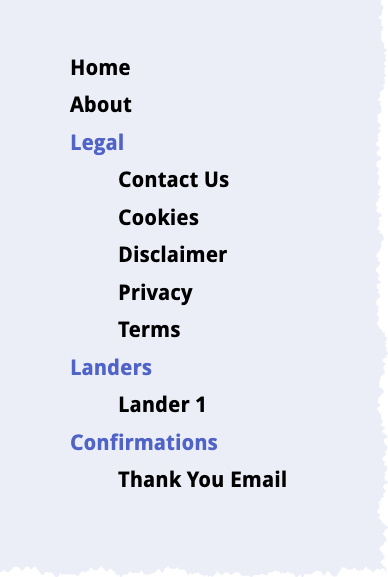Next set up basic pages that you already know you will need. You can always add more later. Having completed the steps on this page you will end up with a page structure like this.

WordPress will install with some existing pages. I do not find these useful so I delete them. At the time of writing this meant deleting the following pages :
After you have deleted these pages they will be sent to trash. So now click onto the trash folder and empty the pages trash.
Create the following pages. They will serve as parent pages in the next step.
Make sure each has no content, and for each one, set the SEO settings under Visibility to be :
Publish each parent page.
Keep a project file (Google Doc will suffice) and note the values of ids of all the parent pages as follows. Your ids will be different to mine.
| Parent Page | Parent Page Id |
| Legal | 25 |
| Landers | 21 |
| Confirmations | 27 |
Create the following pages and give them each a couple of paragraphs of placeholder content which you can get from here.
Assign all the pages listed above, a parent page of Legal.
Create a page called Thank You Email and give it a couple of paragraphs of placeholder content. Assign the Thank You Email page a parent page of Confirmations.
Create a page called Lander 1 and give it a couple of paragraphs of placeholder content. Assign the Lander 1 page a parent page of Landers.
Create a page called About and give it a couple of paragraphs of placeholder content. This page does not require a parent page.
Create a page called Home and give it a couple of paragraphs of placeholder content. This page does not require a parent page.
In order to minimise chaos once the site grows, I found it effective to separate out thank you pages, landing pages, testing pages and standard legal pages from real website content. I did this using sub-pages. It makes all the content easier to find.
Even if you already have content planned, or if you are building a Seed Site, I suggest you use simple placeholder text for now. Once your site is in place you can go back and replace the placeholder text with planned content.
The SEO settings for the parent pages as detailed above, is to ensure that no-one can visit the parent pages, nor stumble across them, nor find them in the search engines.